Planning your own trip? Prepare for your trip
Use Rough Guides' trusted partners for great rates
Plan and book your private, tailor-made tour with vetted local experts
Just 3km south of Portimão, Praia da Rocha is best known for its vast sweep of golden sand backed by honey-colored cliffs. It is one of the best beaches in Algarve, not just for its size, but for the sheer range of things packed into one stretch of coast: sunbeds, surf, cliffside bars, and space to breathe, even in high season.
At the eastern end, the 17th-century Fortaleza de Santa Catarina watches over the mouth of the Rio Arade. From the terrace, you get panoramic views of the Atlantic on one side and the marina on the other.
The rest of Praia da Rocha is louder and less refined. A line of high-rise hotels and bars runs along Avenida Tomás Cabreira, with steep stairs leading down to the beach. The buildings won’t win any design awards, but the sea views make up for it. This is a place built for sunseekers, and it stays busy well beyond summer.

Hi, I’m Luis, your Portugal travel expert. If you are heading to the Algarve for sun, sea, and a laid-back beach break, Praia da Rocha should be on your radar. It is one of the liveliest spots on the southern coast, known for its wide sandy beach, long seafront promenade, and busy nightlife.
This is not a hidden escape. It is a resort town through and through, with high-rise hotels, sunset bars, and beach cafés packed with sunseekers well into the evening. But just below the concrete edge, the beach delivers: golden sand, striking cliffs, and space to breathe, even in high season.
This Praia da Rocha travel guide covers what to expect, when to go, and how to make the most of your time here. No matter if you are planning beach days, boat tours, or just want a cold drink with a sea view, it is all within easy reach.
Luis’s tip
Walk a few blocks inland if you want to eat well without the tourist markup. Then head back to the cliffs for golden hour. The light on the sandstone is unreal, especially just before sunset.
Best time to visit
Spring and autumn are ideal, with long sunny days, warm sea temperatures, and fewer crowds. You will have space on the beach, and the bars and cafés are open but not overwhelmed. July and August bring heat, noise, and big crowds. Shade is limited, so plan for early mornings or late afternoons. Winter is mild and quiet. It is not beach weather, but it is a peaceful time for coastal walks and good-value stays.
How to get to Praia da Rocha
The nearest train station is in Portimão, about 3km away, with services from Lisbon, Faro, and Lagos. From the station, taxis and local buses can get you to the beach in ten minutes. If you are flying into Faro, the drive to Praia da Rocha takes around one hour. There are shuttle services and private transfers available, but renting a car gives you more freedom to explore nearby towns and hidden beaches along the coast.
Best areas to stay in Praia da Rocha
Praia da Rocha is on Portugal’s southern coast in the Algarve, just 3km south of Portimão. It is around an hour’s drive from Faro and about three hours from Lisbon, which makes it one of the easiest beach resorts to reach in the region.
Often highlighted among the best beaches in Portugal, Praia da Rocha combines a vast golden shoreline with lively nightlife and a long seafront promenade. It is a natural stop on a Portugal itinerary that covers the Algarve, especially if you want to mix beach time with boat trips to the Benagil caves, a wander through the old town of Lagos, or a day exploring inland villages and countryside.


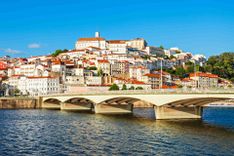
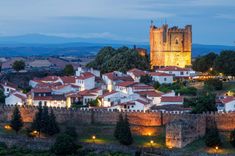

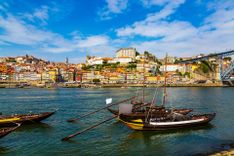










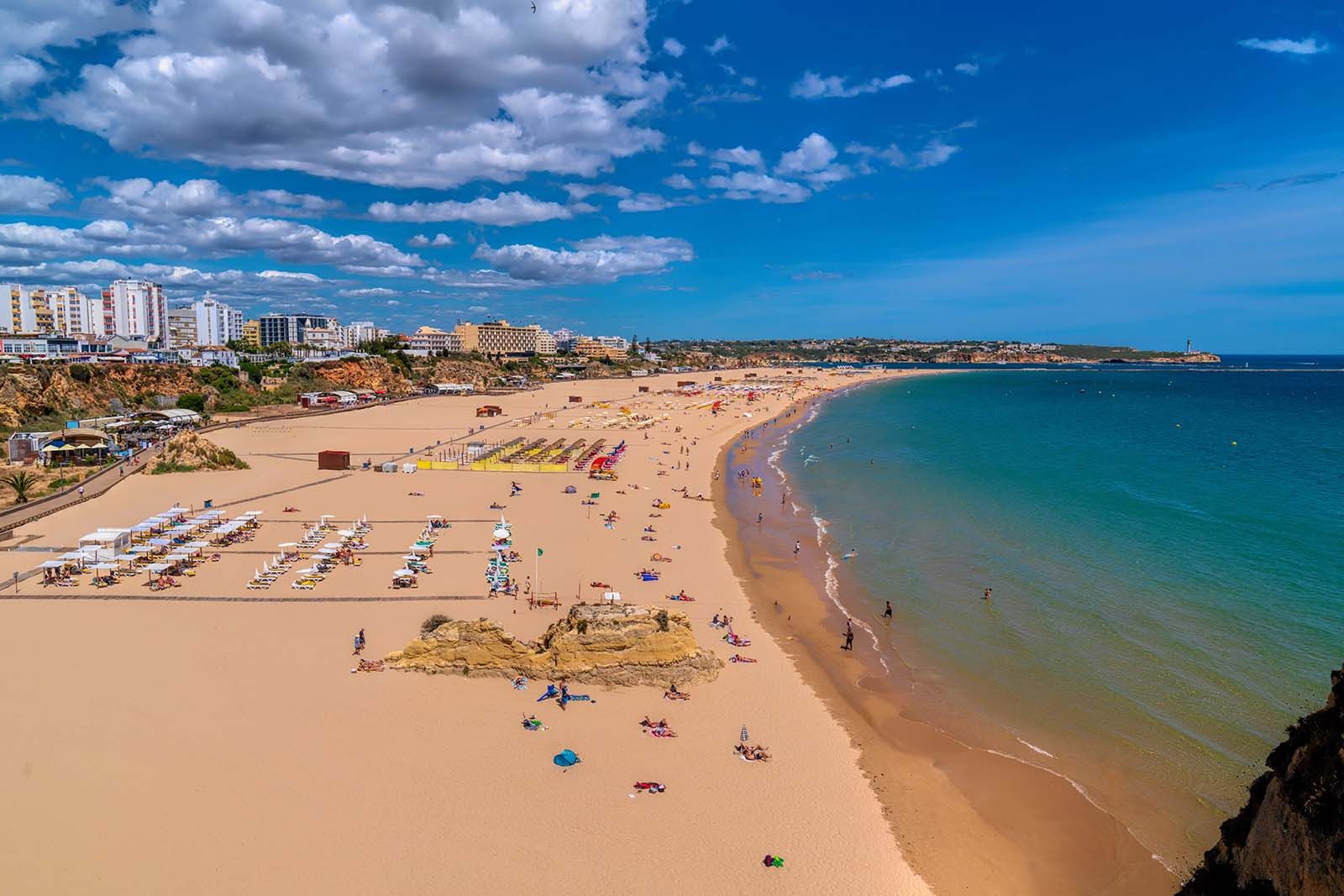
Praia da Rocha © Sopotnicki / Shutterstock
Praia da Rocha is flat, walkable, and designed for beach holidays. Most hotels, restaurants, and bars sit along Avenida Tomás Cabreira or just behind it, so you can easily get around on foot. There is no need for a car if you are staying in the resort itself, but wheels come in handy for day trips along the Algarve coast.
If you are wondering how many days in Praia da Rocha are enough, one full day will give you the basics: time on the sand, a walk along the boardwalk, and sunset drinks overlooking the cliffs. But staying at least two nights lets you balance beach time with a taste of the nightlife that kicks in after dark.
If you are planning a 10-day Portugal itinerary that includes the Algarve, consider spending three days in Praia da Rocha. Dedicate one to the beach itself, another to a boat trip to the Benagil caves or dolphin watching, and the third to exploring nearby towns such as Lagos or the medieval streets of Silves. An extra night also means you can catch both sunrise over the Atlantic and the fiery sunsets the Algarve is famous for.

Benagil caves © Shutterstock
Praia da Rocha has everything from high-rise hotels to serviced apartments and budget hostels. Most places are within a short walk of the sand, but the atmosphere changes depending on where you base yourself.
Praia da Rocha is built for beach life, but its appeal goes well beyond the sand. From historic forts and coastal caves to buzzing nightlife and nearby towns, here are the best things to do in Praia da Rocha, each worth slowing down for.
The wooden boardwalk runs the full length of Praia da Rocha, parallel to the sand and cliffs. It is the best way to appreciate just how vast this beach really is. In the morning, when the air is cool and the beach almost empty, you can wander with a coffee in hand and watch joggers and early swimmers getting their day started. By afternoon, the boardwalk fills with families, beachgoers, and waiters balancing trays of sangria from the restaurants above.
The boardwalk links to several beach bars and staircases down to the sand. Come back at night when live music drifts out of the bars and the cliffs glow under floodlights, turning a casual walk into something atmospheric.
Guarding the mouth of the Rio Arade since 1691, the fortress was built to protect Portimão from pirates and naval raids. Today, it is less about defense and more about views. Climb up to the terrace and you can see across the marina, the estuary, and the full sweep of Praia da Rocha stretching west into the distance.
Inside, there isn’t much in the way of exhibitions, but the thick stone walls and cannon placements still tell the story. Visit in the late afternoon for cooler air and golden light. The fort is free to enter, and a café just outside the walls is a good stop before heading down to the boardwalk.
Praia da Rocha’s beach is the reason people come here. It is vast, golden, and wide enough that even in August you can stretch out without feeling crowded. In places, the sand runs almost half a kilometer from the cliffs to the shoreline, so there is space for everyone. Sunbeds and umbrellas are available to rent, while the middle stretches stay open for those who prefer to lay a towel straight on the sand.
The sea is usually calm, with lifeguards on duty through summer. Families tend to settle near the fort at the eastern end, while surfers and bodyboarders try the western side closer to Praia do Vau. Flip-flops are useful for crossing the sand at midday when it gets hot underfoot. Stay until evening to see the cliffs lit by the setting sun, when the crowds thin and the atmosphere changes.,
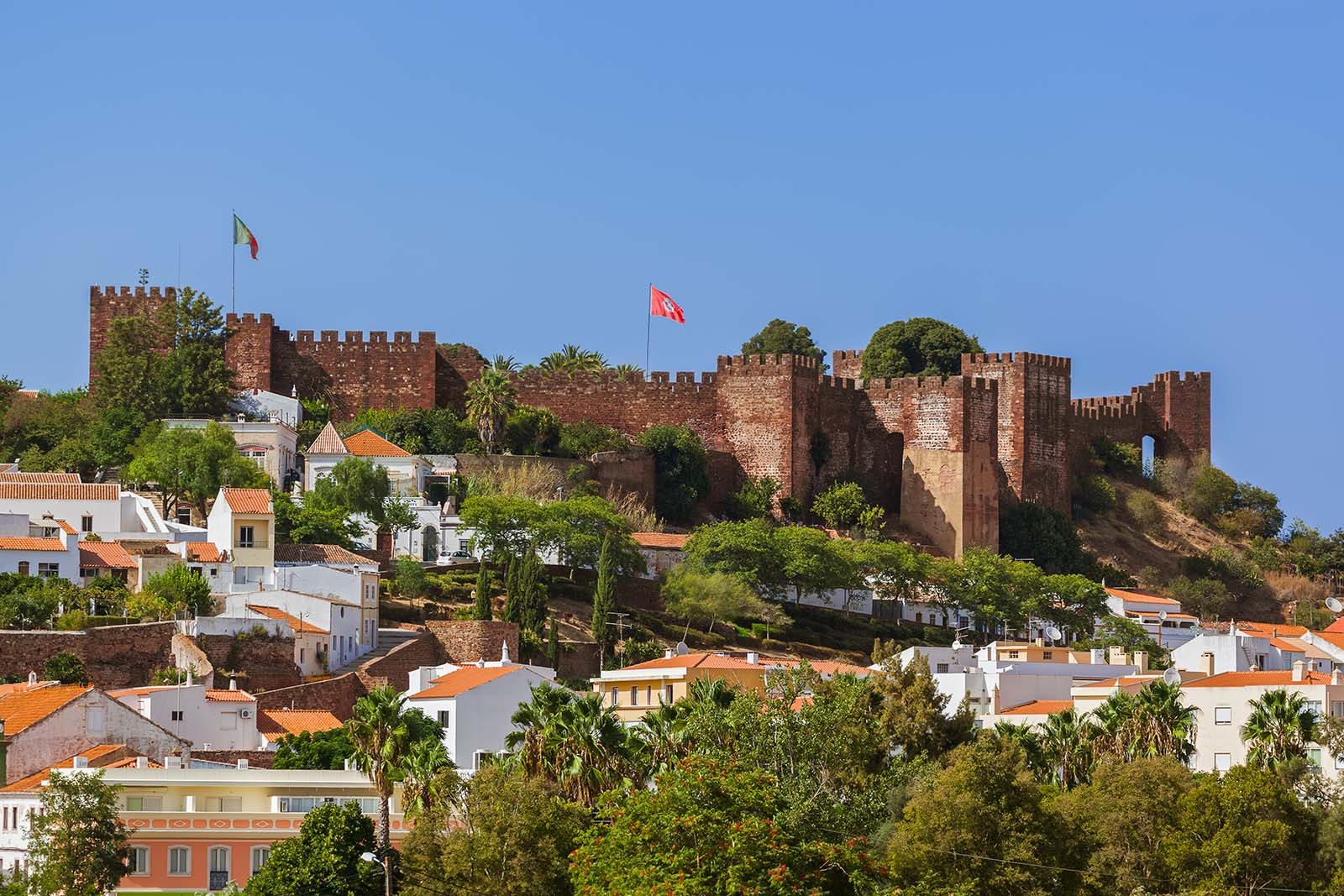
Silves, Portugal © Shutterstock
The Benagil caves are one of the Algarve’s most photographed spots, and Praia da Rocha is an easy jumping-off point. Boats leave from Portimão marina and follow the coast past sandstone cliffs, hidden coves, and rock arches before arriving at the cave’s natural skylight. On calm days, you can see light pouring through the hole in the ceiling, illuminating the sand inside like a spotlight.
Some tours add dolphin watching, snorkeling stops, or visits to smaller caves. Go in the morning before the winds pick up and the sea gets choppy. Kayak and SUP tours are also available if you want to paddle right into the cave yourself, though you’ll need a reasonable level of fitness.
Praia da Rocha has every watersport you can imagine. Rental huts along the sand offer jet skis, paddleboards, kayaks, and parasailing. Banana boats and inflatable rides keep families and groups entertained, while calmer conditions in summer make it easy for beginners to try stand-up paddleboarding close to shore.
For surfing, head west toward Praia do Vau, where waves are more reliable. Most operators provide gear and lessons, so you can spend a couple of hours on the water and then retreat to a beach bar to recover.
Just inland, Portimão feels like a different world from the resort strip. The riverside promenade is lined with cafés serving grilled sardines, the town’s most famous dish, and you can watch fishermen mending nets on the quayside. The Portimão Museum, housed in a former fish cannery, gives insight into the town’s maritime past with displays on sardine fishing and shipbuilding.
The municipal market is also worth a wander in the morning, with stalls piled high with Algarve oranges, figs, and fresh fish. Pair a market visit with lunch in a traditional tasca, where prices are lower and the pace is slower than at the beachfront.
Praia da Rocha has one of the liveliest nightlife scenes in the Algarve. Avenida Tomás Cabreira, the strip that runs along the cliff, turns into a neon-lit party zone after dark. Rooftop bars serve cocktails with sea views, open-air clubs pump music until sunrise, and smaller beach bars keep the vibe casual with live music and DJ sets.
July and August are the busiest months, drawing international DJs and big crowds, but even in spring and autumn, there is always somewhere open. For a more relaxed night, stick to the terrace bars overlooking the sand.
Just 20 minutes west, Lagos offers a blend of historic streets and dramatic coastline. Within the old city walls, you’ll find narrow alleys, tiled houses, and lively squares. Down at the marina, restaurants spill out onto terraces overlooking the yachts.
The real highlight, though, is Ponta da Piedade, a series of jagged cliffs and rock arches rising out of turquoise water. Boat trips from Lagos weave between the formations, while cliff-top paths give some of the best coastal views in southern Portugal.
Drive 30 minutes inland and you’ll reach Silves, the Algarve’s former Moorish capital. Its red sandstone castle dominates the skyline and offers panoramic views of the surrounding hills. Inside, you can explore restored walls, cisterns, and a small archaeological museum.
The town itself has narrow cobbled streets, whitewashed houses, and a Gothic cathedral built on the site of a former mosque. Visit during the Silves Medieval Festival in August, when the streets fill with markets, music, and costumed performers.
Few places on the Algarve coast match Praia da Rocha for sunset. Climb to one of the cliff-top viewpoints west of the beach and watch the sky shift from orange to purple as the Atlantic darkens below. Praia do Vau and Praia dos Três Castelos are quieter than the main strip and just a short walk away.
Bring a drink, find a ledge on the cliffs, and stay until the lights of the town flicker on behind you. It is the perfect way to round off a day in Praia da Rocha.
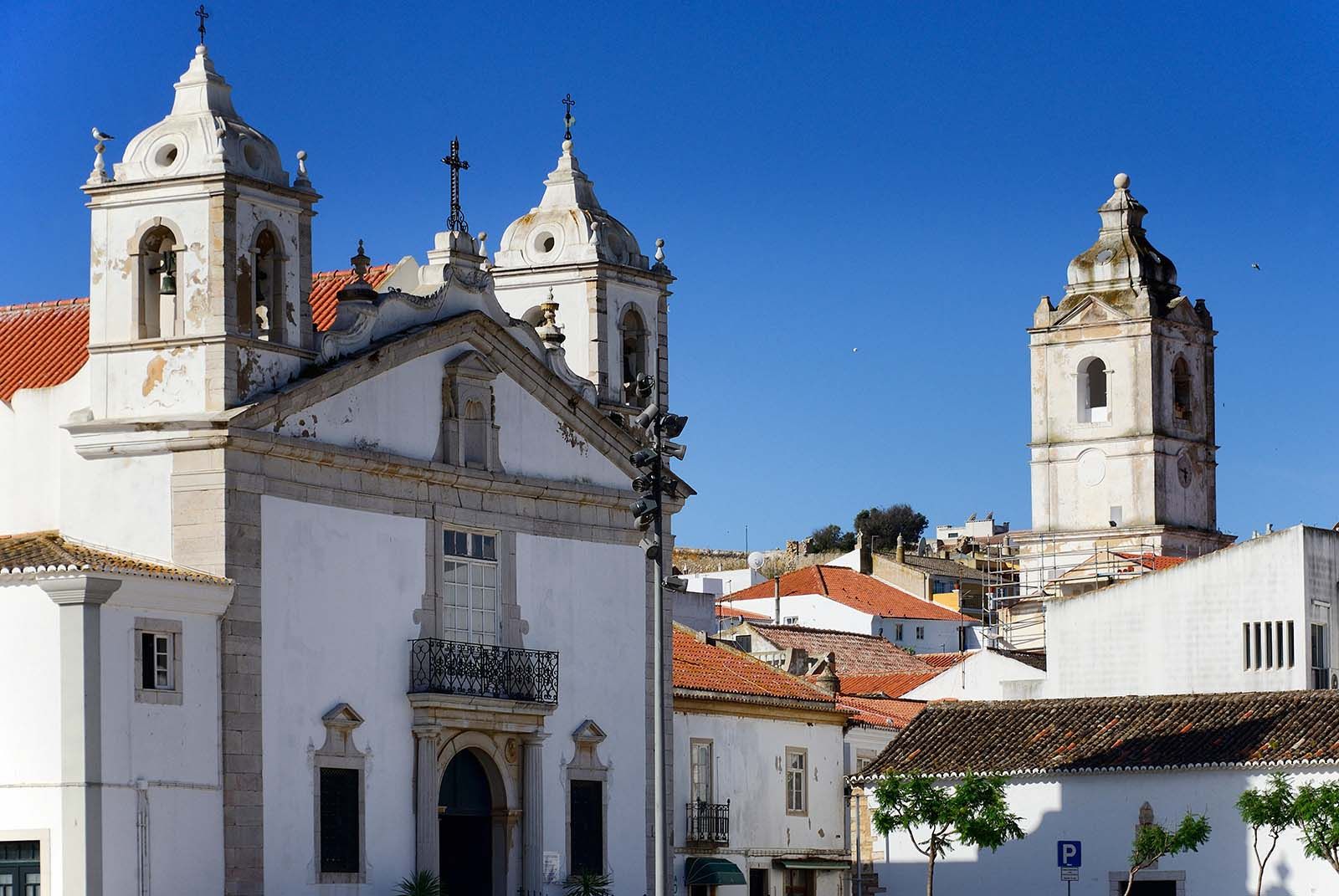
Lagos old town © Shutterstock
Praia da Rocha has a Mediterranean climate with strong Atlantic influence, which means hot, dry summers, mild winters, and a reliable sea breeze that never quite disappears. Compared with inland Algarve towns, the resort is cooler in summer but windier in winter. Average temperatures range from about 54°F (12°C) in January to 84°F (29°C) in August, with the sea staying warm enough for swimming well into autumn. For current conditions, check IPMA (Portuguese Institute for Sea and Atmosphere).
Praia da Rocha’s dining scene is shaped by the sea. Fresh fish and seafood dominate menus, with grilled sardines, octopus, and shellfish served in everything from beach shacks to terrace restaurants overlooking the sand. You’ll also find plenty of international options, but it’s worth seeking out local Algarve flavors while you’re here. Expect hearty portions, simple cooking, and a relaxed holiday vibe.
Our local guides have put together a set of experiences that show Praia da Rocha at its best, each one private, adaptable, and made to match your style of travel.
Discover Portugal's most captivating stories
Use Rough Guides' trusted partners for great rates
written by
Andy Turner